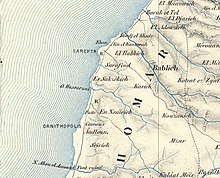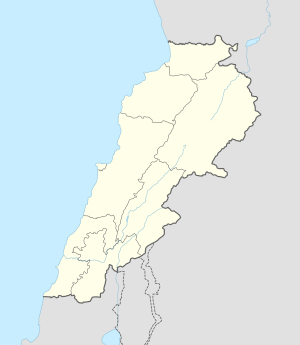As-Sarafand
As-Sarafand الصرفند | |
|---|---|
Municipality | |
 Glassmaking in As-Sarafand | |
| Coordinates: 33°27′06″N 35°17′27″E / 33.45167°N 35.29083°E | |
| Country | |
| Governorate | South Governorate |
| District | Sidon District |
| Government | |
| • Type | Mayor–council |
| Elevation | 70 m (230 ft) |
| Population (2004) | 10,965 |
| Time zone | UTC+2 (EET) |
| • Summer (DST) | UTC+3 (EEST) |
| Dialing code | 00961 (7) Landline |
As-Sarafand (Arabic: الصرفند) is a municipality in southern Lebanon located 10 km south of Sidon overlooking the Mediterranean Sea.
Etymology
As-Sarafand is an Arabic rendition of the Phoenician place-name Ṣrpt,[2] after Classical Sarepta, just north of Sarafand.[3]

History
In 1875 Victor Guérin noted that the village had 400 Métualis inhabitants.[4]
In mid-April 1980 Israeli commandos, arriving by sea, raided As-Sarafand killing twenty Lebanese and Palestinians, mostly civilians. During the first three weeks of April the Israelis carried out similar, but smaller, raids along the coast road between Sidon and Tyre, killing thirteen people.[5]
On 7 June 1982, on the second day of the Israeli invasion of Lebanon an IDF brigade was ambushed as it pushed through As-Sarafand. Two Israeli soldiers were killed and one seriously wounded.[6]
Demographics
In 2014, Muslims made up 99.63% of registered voters in As-Sarafand. 96.90% of the voters were Shiite Muslims.[7]
References
- ^ Sarafand, Localiban
- ^ Marom, Roy; Zadok, Ran (2023). "Early-Ottoman Palestinian Toponymy: A Linguistic Analysis of the (Micro-)Toponyms in Haseki Sultan's Endowment Deed (1552)". Zeitschrift des Deutschen Palästina-Vereins. 139 (2).
- ^ Nicolas Carayon (2012–2013), "Les ports phéniciens du Liban" (PDF), Archaeology& History in the Lebanon Issue
- ^ Guérin, 1880, p. 482: "A sept heures, j'examine, en me dirigeant vers l'est-sud-est, quatre anciens tombeaux pratiqués dans le roc, sur les pentes de la colline que couronne le village de Sarfend. Un peu plus loin, vers le sud, on remarque une antique carrière et une grande caverne, qui, au dire des habitants du pays, est très étendue; actuellement l'entrée en est obstruée par d'énormes blocs tombés de la voûte. On l'appelle Merharet ei-Haloueh. De là, je monte à Sarfend. Ce village a une population de 400 Métualis. Il a hérité, mais en le modifiant un peu, du nom de Sarepta, ville à laquelle il parait avoir succédé, mais sur un autre emplacement, quand celle-ci a été détruite. Redescendant bientôt vers le sud, je rencontre, un kilomètre plus loin, d'autres tombeaux creusés dans le roc et divers débris de sarcophages."
- ^ Middle East International No 125, 23 May 1980; Helena Cobban p.4
- ^ Schiff, Ze’ev and Ya’ari, Ehud (1985) Israel’s Lebanon War. George Allen and Unwin Ltd, ISBN 0-04-923078-6 pp.138-139
- ^ "التوزيع حسب المذاهب للناخبين/ناخبات في بلدة الصرفند، قضاء صيدا (قرى) محافظة الجنوب في لبنان". إعْرَفْ لبنان.
Bibliography
- Guérin, V. (1880). Description Géographique Historique et Archéologique de la Palestine (in French). Vol. 3: Galilee, pt. 2. Paris: L'Imprimerie Nationale.
External links
- Sarafand, Localiban


